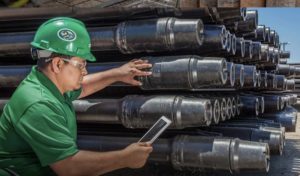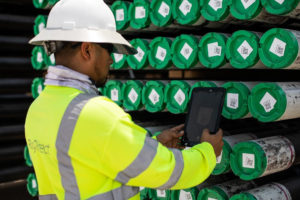One wouldn’t think that something as simple as a cylinder would offer many prospects for innovation.
But one would be wrong. The metal cylinder known as pipe has attracted a wave of innovation and sophistication in the shale era.
 Oilfield pipe, commonly described as “oil country tubular goods, or OCTG, falls into four categories: drill pipe, casing pipe, tubing, and line pipe. The first three are fairly self-explanatory, and the fourth can be more easily understood if one thinks of that pipe as something that is laid horizontally, and at or near the surface, not downhole. Thus, line pipe is generally what is used for pipelines or gathering lines. But all four kinds have all seen improvements and technological advances.
Oilfield pipe, commonly described as “oil country tubular goods, or OCTG, falls into four categories: drill pipe, casing pipe, tubing, and line pipe. The first three are fairly self-explanatory, and the fourth can be more easily understood if one thinks of that pipe as something that is laid horizontally, and at or near the surface, not downhole. Thus, line pipe is generally what is used for pipelines or gathering lines. But all four kinds have all seen improvements and technological advances.
Sure, the market has encountered some bumps here and there. Supply chain woes have complicated the market for pipe, for one thing.
As UpstreamOnline.com reported in June, a shortage of steel and a range of key pieces to the drilling puzzle are causing consternation in the drilling sector.
“Drill pipe, casing, and other tubular goods are in short supply in the United States due to the global supply chain constrictions that have followed on from the Covid-19 pandemic and the war in Ukraine,” the site explained. “Shortages and delays in these critical supply chain industries for the drilling sector have been limiting production growth in the United States, despite ample price incentives to pursue growth.”
For all of that, however, the metamorphosis in tubular goods has continued unabated. And in some areas, growth is apparent as well.
As recently as July, a major manufacturer and supplier of pipe made a pro-active move that suggests confidence in the long(er) term health of the sector. Tenaris announced it had entered into an agreement to acquire Bentler Steel and Tube Manufacturing Corporation, based in Shreveport, La., for $460 million. Bentler is a producer of seamless steel pipe, with an annual pipe rolling capacity of up to 400,000 metric tons at its production facility located in Shreveport, La. The acquisition will further expand Tenaris’s production range and local manufacturing presence in the U.S. market.
Also in July, a report emerged from Allied Market Research that indicates that the market for drill pipe, which amounted to $1.3 billion globally in 2021, will hit $2.2 billion by 2031, or an increase of 5.4 percent cumulative annual growth rate. The report stated that the rise in exploration and drilling activities for oil across the globe and the increase in the redevelopment of mature oil wells will drive the growth of the market.
They added: “On the other hand, variations in raw material prices restrain the growth to some extent. However, the surge in focus toward sustainable oil and gas production presents new opportunities in the future.”
Company Gets Ingenius
A ground-breaking new line of high strength austenitic stainless steels has been developed that promises to transform how materials are specified and utilized across the oil and gas sector.
Called
The N’GENIUS SeriesTM repre
Called the “N’Genius Series,” this development becomes the latest entry into the mix of “corrosion resistant alloys (CRAs) currently on the market. Dr C.V. Roscoe, inventor of the original 25Cr super-duplex stainless steel and CEO of N’Genius Materials Technology, explained:
“The extensive range of alloy types, variants, and grades in the N’Genius series have strength properties equivalent to duplex and super-duplex stainless steels, as well as ductility and toughness levels normally associated with conventional austenitic stainless steels, but with far superior corrosion resistance to suit all major oil and gas projects.” 
The company contends that these and other key engineering design characteristics will allow a broad range of product forms and ancillary equipment to be designed, specified, manufactured, and supplied with the objective of reducing wall thicknesses and overall size, using less material and producing lighter products. This makes products easier to handle and transport to site, leading to weight savings, and an overall reduction in construction and project costs.
Tuboscope Touts Solutions
Tuboscope, which is a subsidiary of NOV, specializes in pipe and pipe service. One of their divisions offers what is called TracID Lifecycle Management. The system allows for tracking assets “downhole and around the world.”
Utilizing field-proven RFID technology and proprietary software solutions, TracID captures detailed asset history from manufacture to end of useful life, making it accessible when users need it via TracID’s software solutions. The company’s TruData inspection and reporting service allows customers to monitor the status and condition of their fleet to identify problems, prevent improper care and handling, and ensure proper fit-for-purpose application of drill stem components. 
Drill pipe is one of the most expensive and critical assets in a drilling program and the unplanned purchase of drill string assets costs pipe owners millions in unnecessary expenses each year. Traditional fleet management programs have proven to be taxing and ineffective, resulting in excess capital invested in drill pipe. Worn serial numbers are difficult to read and can result in misidentification of asset records that leads to costly downhole failures or unnecessary inspections and repairs. NOV’s TracID Lifecycle Management is meant to provide clarity, cost-savings, and confidence by eliminating the guesswork around how to best use and maintain drill stem assets.
By application, the onshore segment accounted for more than two-thirds of the global drill pipe market revenue in 2021, and will dominate by 2031. This is owing to the fact that onshore wells are comparatively easy to drill and are available in large quantities, which makes the extraction process easier as compared to offshore wells. At the same time, the offshore segment would manifest the fastest CAGR of 5.7% during the forecast period. This is due to rapid depletion of oil reserves in onshore oil wells.
Tenaris Traces Pipe
 The aforementioned Tenaris is making headway of its own with a pipe tracking system of its own. We’ve mentioned this development before, but it bears repeating. Tenaris’ PipeTracer technology gives pipe handling personnel the opportunity to track and trace the use of their tubulars. The thread protectors on the ends of pipe are each stickered with a scannable QR code. Personnel can use a downloadable app on their phone or tablet to read each code and get all pertinent details on that particular length of pipe. The system allows operators to identify Tenaris products on-site in real time, improving accuracy, streamlining operations, and increasing safety through less pipe handling.
The aforementioned Tenaris is making headway of its own with a pipe tracking system of its own. We’ve mentioned this development before, but it bears repeating. Tenaris’ PipeTracer technology gives pipe handling personnel the opportunity to track and trace the use of their tubulars. The thread protectors on the ends of pipe are each stickered with a scannable QR code. Personnel can use a downloadable app on their phone or tablet to read each code and get all pertinent details on that particular length of pipe. The system allows operators to identify Tenaris products on-site in real time, improving accuracy, streamlining operations, and increasing safety through less pipe handling.
These are just a few examples of innovations that are transforming the world of OCTG. Once the O&G world gets fully back on track itself, free of supply train constraints, governmental policy hindrances, and price instability, things should be “good to go.” Of course, those conditions never all apply at once, so we’ll likely just have to forge ahead with what we can muster. But pipe will be ready when we do.
_____________________________________________________________________________________________________
By Jesse Mullins









